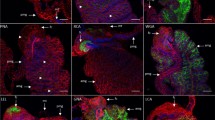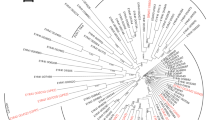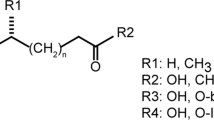Abstract
Many nematode-trapping fungi capture nematodes using an adhesive present on specific capture organs (for review see ref. 1). Until recently, the mechanism of adhesion was completely unknown. In the case of Arthrobotrys oligospora, one of the most common nematophagous fungi, nematodes are trapped in three-dimensional structures of the adhesive network type (Fig. 1a). When a suspension of nematodes is added to an agar culture of the fungus, nematodes are immediately captured and firmly held by the traps. The nematode cuticle is lysed at the point of contact and penetrated by a hypha within one hour2. An increased secretion by the fungus of a mucilaginous substance in the presence of prey has been shown by scanning and transmission electron microscopy2,3. Our hypothesis is that the firmness of attachment to the traps despite the struggle of the nematode is due to a series of events, beginning with an interaction between complementary molecular configurations on the nematode and fungal surfaces. We show evidence here for the presence of a lectin on the traps of A. oligospora which binds to a carbohydrate on the nematode surface.
This is a preview of subscription content, access via your institution
Access options
Subscribe to this journal
Receive 51 print issues and online access
$199.00 per year
only $3.90 per issue
Buy this article
- Purchase on Springer Link
- Instant access to full article PDF
Prices may be subject to local taxes which are calculated during checkout
Similar content being viewed by others
References
Barron, G. L. The Nematode-Destroying Fungi, 21–46 (Canadian Biological Publications Ltd., Guelph, Ontario, Canada, 1977).
Nordbring-Hertz, B. & Stålhammer-Carlemalm, M. Can. J. Bot. 56(10), 1297–1307 (1978).
Nordbring-Hertz, B. Physiologia Pl. 26, 279–284 (1972).
Rosen, S. D., Kafka, J. A., Simpson, D. L. & Barondes, S. H. Proc. natn. Acad. Sci. U.S.A. 70(9), 2554–2557, (1973).
Rosen, S. D., Simpson, D. L., Rose, J. E. & Barondes, S. H. Nature 252, 149–151 (1974).
Frazier, W. A., Rosen, S. D., Reitherman, R. W. & Barondes, S. H. J. biol. Chem. 250(19), 7714–7721 (1975).
Lockhart, C. M., Rowell, P. & Stewart, W. D. P. FEMS microbiol. Lett. 3, 127–130 (1978).
Dazzo, F. B. & Hubbel, D. H. Appl. Microbiol. 30(6), 1017–1033 (1975).
Wolpert, J.S. & Albersheim, P. Biochem. biophys. Res. Commun. 70(3), 729–737 (1976).
Dazzo, F. B. & Brill, W. J. Appl. environment. Microbiol. 33(1), 132–136 (1977).
Bhuvaneswari, T. V., Pueppke, S. G. & Bauer, W. D. Pl. Physiol. 60, 486–491 (1977).
Nordbring-Hertz, B. Trans. Br. mycol. Soc. 68, 53–57 (1977).
Goldstein, I. J. & Hayes, C. E. Adv. Carbohyd. Chem. Biochem. 35, 127–340 (1978).
Wilson, M.B. & Nakane, P.K. in Immunofluorescence and Related Staining Techniques (eds Knapp, W., Holubar, K. & Wick, G.) 215–224 (Elsevier, Amsterdam, 1978).
Hammarström, S. Ann. N.Y. Acad. Sci 234, 183–197 (1974).
Lott, J. A. & Turner, K. Clin. Chem. 21, 1754–1760 (1975).
Mattiasson, B. & Mosbach, K. Meth. Enzym. 44, 335–353 (1976).
Nordbring-Hertz, B. Physiologia Pl. 29, 223–233 (1973).
Author information
Authors and Affiliations
Rights and permissions
About this article
Cite this article
Nordbring-Hertz, B., Mattiasson, B. Action of a nematode-trapping fungus shows lectin-mediated host–microorganism interaction. Nature 281, 477–479 (1979). https://doi.org/10.1038/281477a0
Received:
Accepted:
Issue Date:
DOI: https://doi.org/10.1038/281477a0
This article is cited by
-
Bio-organics Management: Novel Strategies to Manage Root-knot Nematode, Meloidogyne incognita Pest of Vegetable Crops
Gesunde Pflanzen (2023)
-
Biological control: a novel strategy for the control of the plant parasitic nematodes
Antonie van Leeuwenhoek (2021)
-
The Role of Melanin in the Biology and Ecology of Nematophagous Fungi
Journal of Chemical Ecology (2021)
-
Predator-prey interactions of nematode-trapping fungi and nematodes: both sides of the coin
Applied Microbiology and Biotechnology (2018)
Comments
By submitting a comment you agree to abide by our Terms and Community Guidelines. If you find something abusive or that does not comply with our terms or guidelines please flag it as inappropriate.



